Jorge Gomez-Ponce
An Ultra-Wideband Study of Vegetation Impact on Upper Midband / FR3 Communication
Dec 20, 2024Abstract:Growing demand for high data rates is driving interest in the upper mid-band (FR 3) spectrum (6-24 GHz). While some propagation measurements exist in literature, the impact of vegetation on link performance remains under-explored. This study examines vegetation-induced losses in an urban scenario across 6-18 GHz. A simple method for calculating vegetation depth is introduced, along with a model that quantifies additional attenuation based on vegetation depth and frequency, divided into 1 GHz sub-bands. We see that excess vegetation loss increases with vegetation depth and higher frequencies. These findings provide insights for designing reliable, foliage-aware communication networks in FR 3.
Site-Specific Radio Channel Representation -- Current State and Future Applications
Jun 18, 2024



Abstract:A site-specific radio channel representation considers the surroundings of the communication system through the environment geometry, such as buildings, vegetation, and mobile objects including their material and surface properties. In this article, we focus on communication technologies for 5G and beyond that are increasingly able to exploit the specific environment geometry for both communication and sensing. We present methods for a site-specific radio channel representation that is spatially consistent, such that mobile transmitter and receveiver cause a correlated time-varying channel impulse response. When modelled as random, this channel impulse response has non-stationary statistical properties, i.e., a time-variant Doppler spectrum, power delay profile, K-factor and spatial correlation. A site-specific radio channel representation will enable research into emerging 5G and beyond technologies such as distributed multiple-input multiple-output systems, reconfigurable intelligent surfaces, multi-band communication, and joint communication and sensing. These 5G and beyond technologies will be deployed for a wide range of environments, from dense urban areas to railways, road transportation, industrial automation, and unmanned aerial vehicles.
Cell-free massive MIMO Channels in an Urban Environment -- Measurements and Channel Statistics
Jun 03, 2024
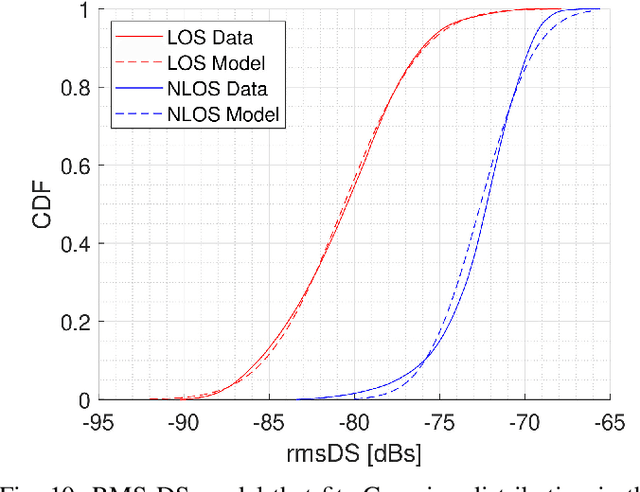
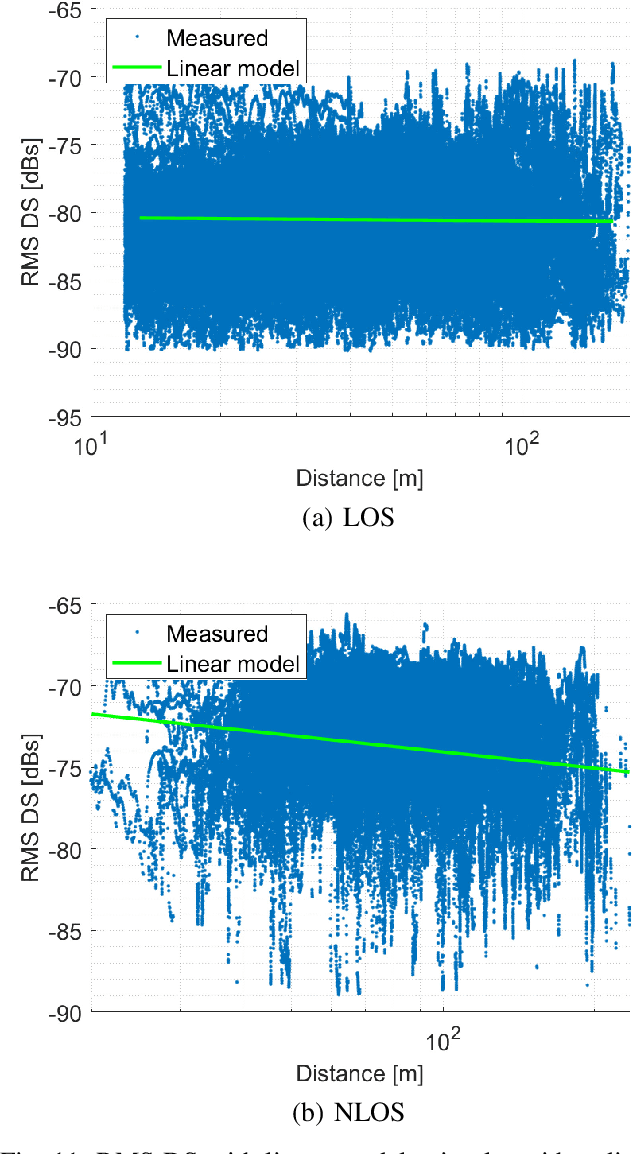
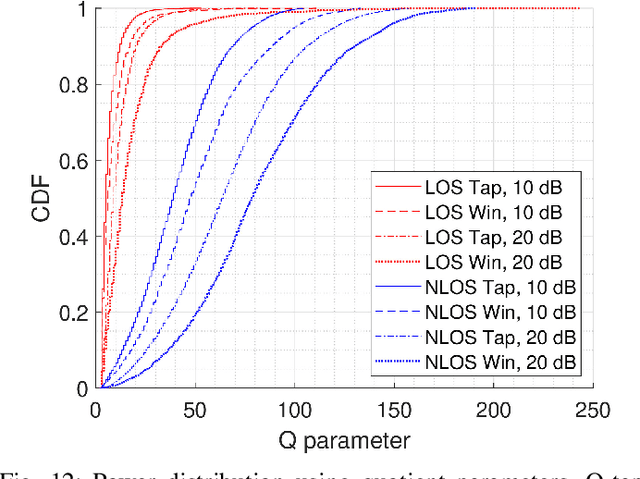
Abstract:Cell-free massive MIMO (CF-mMIMO), where each user equipment (UE) is connected to multiple access points (APs), is emerging as an important component for 5G and 6G cellular systems. Accurate channel models based on measurements are required to optimize their design and deployment. This paper presents an extensive measurement campaign for CF-mMIMO in an urban environment. A new "virtual AP" technique measures channels between 80 UE locations and more than 20,000 possible microcellular AP locations. Measurements are done at 3.5 GHz carrier frequency with 350 MHz bandwidth (BW). The paper describes the measurement setup and data processing, shows sample results and their physical interpretation, and provides statistics for key quantities such as pathloss, shadowing, delay spread (DS), and delay window. We find pathloss coefficients of 2.9 and 10.4 for line-of-sight (LOS) and non line-of-sight (NLOS), respectively, where the high LOS coefficient is mainly because larger distance leads to more grazing angle of incidence and thus lower antenna gain in our setup. Shadowing standard deviations are 5.1/16.6 dB, and root mean squared (RMS) DSs of -80.6/-72.6 dBs. The measurements can also be used for parameterizing a CUNEC-type model, which will be reported in future work.
Large-scale Outdoor Cell-free mMIMO Channel Measurement in an Urban Scenario at 3.5 GHz
May 31, 2024Abstract:The design of cell-free massive MIMO (CF-mMIMO) systems requires accurate, measurement-based channel models. This paper provides the first results from the by far most extensive outdoor measurement campaign for CF-mMIMO channels in an urban environment. We measured impulse responses between over 20,000 potential access point (AP) locations and 80 user equipments (UEs) at 3.5 GHz with 350 MHz bandwidth (BW). Measurements use a "virtual array" approach at the AP and a hybrid switched/virtual approach at the UE. This paper describes the sounder design, measurement environment, data processing, and sample results, particularly the evolution of the power-delay profiles (PDPs) as a function of the AP locations, and its relation to the propagation environment.
THz Band Channel Measurements and Statistical Modeling for Urban Microcellular Environments
Dec 03, 2021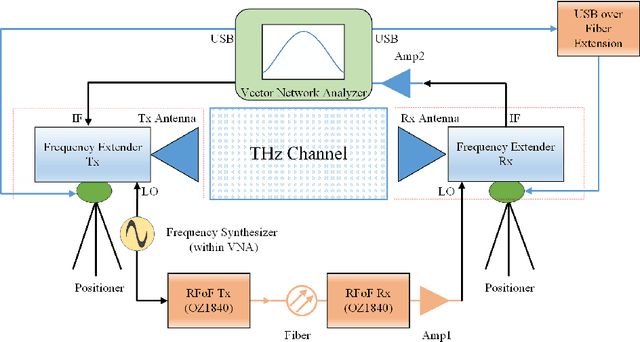
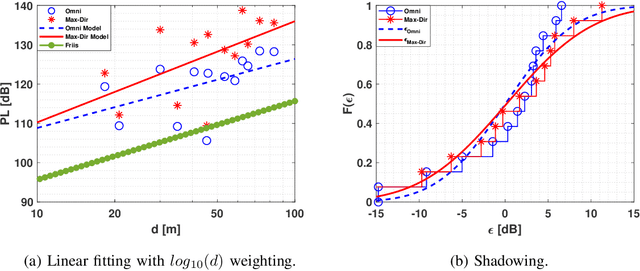
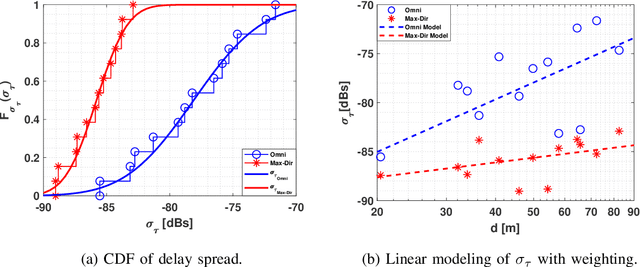
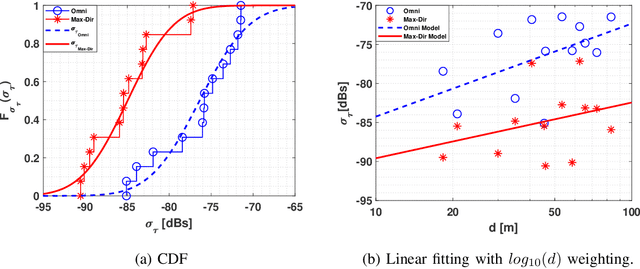
Abstract:The THz band (0.1-10 THz) has attracted considerable attention for next-generation wireless communications, due to the large amount of available bandwidth that may be key to meet the rapidly increasing data rate requirements. Before deploying a system in this band, a detailed wireless channel analysis is required as the basis for proper design and testing of system implementations. One of the most important deployment scenarios of this band is the outdoor microcellular environment, where the Transmitter (Tx) and the Receiver (Rx) have a significant height difference (typically $ \ge 10$ m). In this paper, we present double-directional (i.e., directionally resolved at both link ends) channel measurements in such a microcellular scenario encompassing street canyons and an open square. Measurements are done for a 1 GHz bandwidth between 145-146 GHz and an antenna beamwidth of 13 degree; distances between Tx and Rx are up to 85 m and the Tx is at a height of 11.5 m from the ground. The measurements are analyzed to estimate path loss, shadowing, delay spread, angular spread, and multipath component (MPC) power distribution. These results allow the development of more realistic and detailed THz channel models and system performance assessment.
Energy Efficiency of Uplink Cell-Free Massive MIMO With Transmit Power Control in Measured Propagation Channel
Nov 03, 2021



Abstract:Cell-free massive MIMO (CF-mMIMO) provides wireless connectivity for a large number of user equipments (UEs) using access points (APs) distributed across a wide area with high spectral efficiency (SE). The energy efficiency (EE) of the uplink is determined by (i) the transmit power control (TPC) algorithms, (ii) the numbers, configurations, and locations of the APs and the UEs, and (iii) the propagation channels between the APs and the UEs. This paper investigates all three aspects, based on extensive (~30,000 possible AP locations and 128 possible UE locations) channel measurement data at 3.5 GHz. We compare three different TPC algorithms, namely maximization of transmit power (max-power), maximization of minimum SE (max-min SE), and maximization of minimum EE (max-min EE) while guaranteeing a target SE. We also compare various antenna arrangements including fully-distributed and semi-distributed systems, where APs can be located on a regular grid or randomly, and the UEs can be placed in clusters or far apart. Overall, we show that the max-min EE TPC is highly effective in improving the uplink EE, especially when no UE within a set of served UEs is in a bad channel condition and when the BS antennas are fully-distributed.
THz Band Channel Measurements and Statistical Modeling for Urban D2D Environments
Sep 28, 2021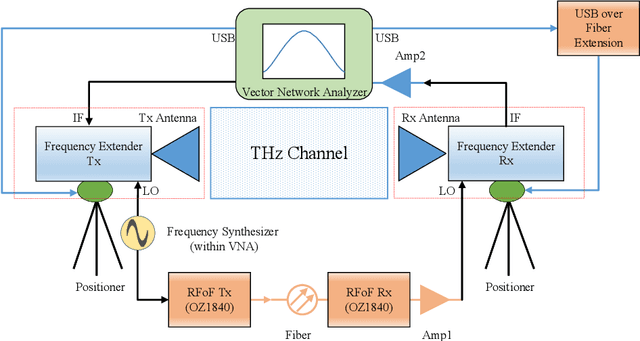
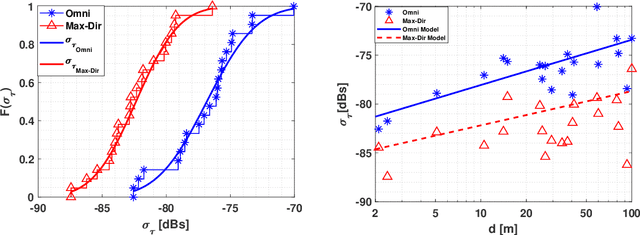
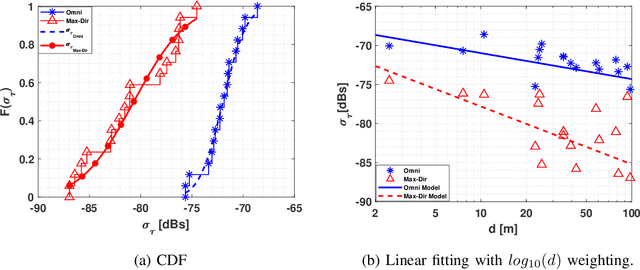
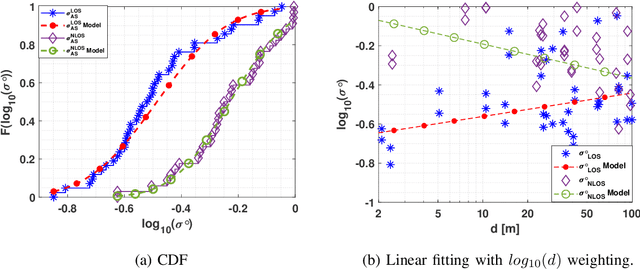
Abstract:THz band is envisioned to be used in 6G systems to meet the ever-increasing demand for data rate. However, before an eventual system design and deployment can proceed, detailed channel sounding measurements are required to understand key channel characteristics. In this paper, we present a first extensive set of channel measurements for urban outdoor environments that are ultra-wideband (1 GHz 3dB bandwidth), and double-directional where both the transmitter and receiver are at the same height. In all, we present measurements at 38 Tx/Rx location pairs, consisting of a total of nearly 50,000 impulse responses, at both line-of-sight (LoS) and non-line-of-sight (NLoS) cases in the 1-100 m range. We provide modeling for path loss, shadowing, delay spread, angular spread and multipath component (MPC) power distribution. We find, among other things, that outdoor communication over tens of meters is feasible in this frequency range even in NLoS scenarios, that omni-directional delay spreads of up to 100 ns, and directional delay spreads of up to 10 ns are observed, while angular spreads are also quite significant, and a surprisingly large number of MPCs are observed for 1 GHz bandwidth and 13 degree beamwidth. These results constitute an important first step towards better understanding the wireless channel in the THz band.
 Add to Chrome
Add to Chrome Add to Firefox
Add to Firefox Add to Edge
Add to Edge